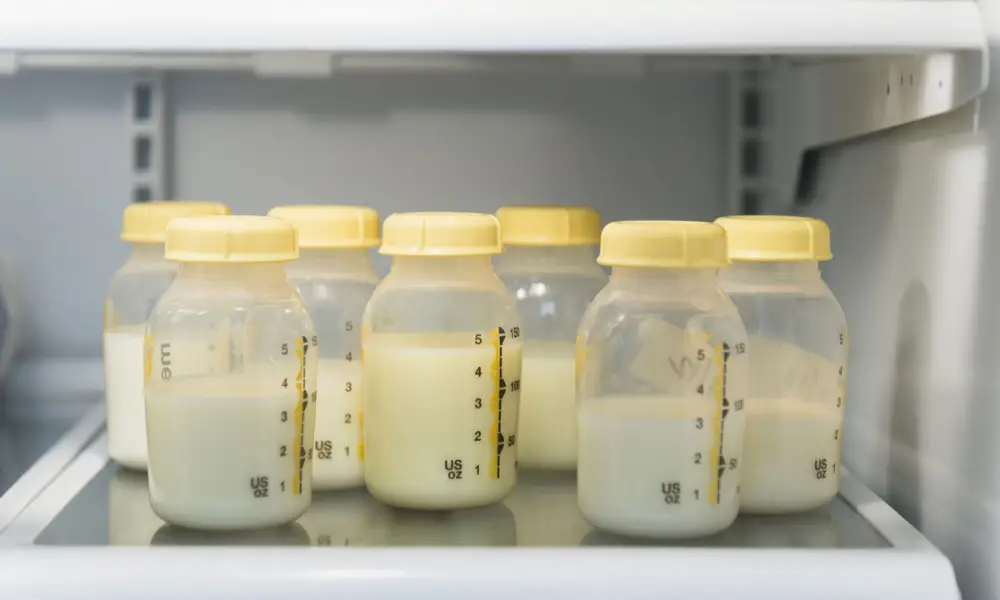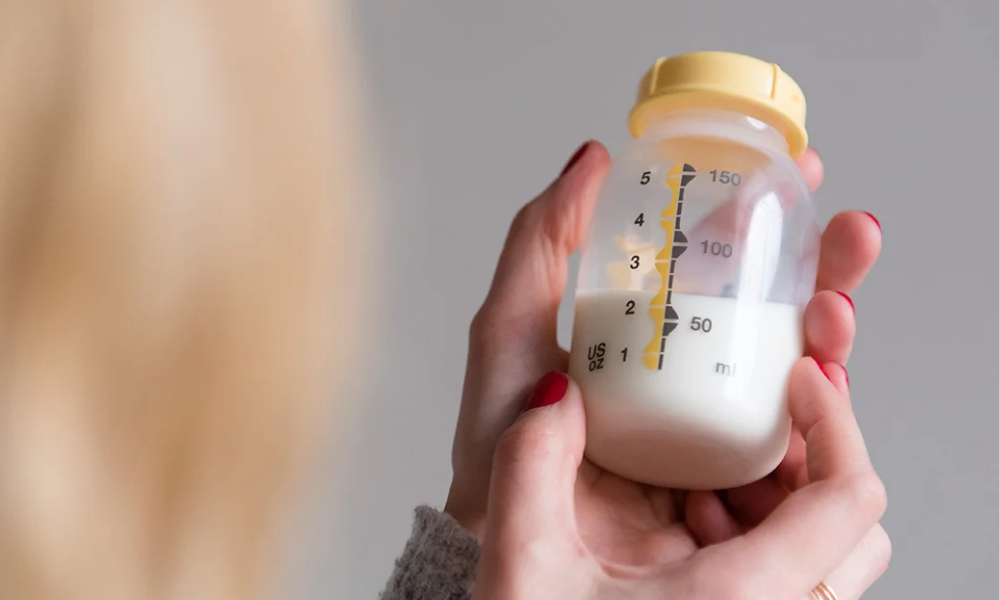Always handle milk in incredibly clean settings, and adhere to storage time recommendations for safe breast milk preservation. The “rule of 4” might help you track how long pumped breast milk is safe to use: 4 hours at room temperature and four days in the fridge. With frozen milk, you have a little more wiggle room; it’s best when used within six months, but it can last up to a year. If your child starts a bottle but doesn’t complete it, use it immediately or throw it away.
For up to 8 days, breast milk can be kept in the refrigerator (at 39 degrees Fahrenheit or lower). However, this limit is for optimal hygienic conditions; it does not imply that the milk will not degrade in any way during that time. Utilize breast milk in the refrigerator for no more than four days for optimum quality (vitamin content and immunity-boosting qualities).

How Long does Breast Milk Last in the Fridge?
Inside a Refrigerator
Ensure your refrigerator is at least 40 degrees Fahrenheit if you want to store newly expressed or pumped breast milk for up to four days. Always store breast milk in the back of the refrigerator, where it is the coolest, as the temperature changes in the door may cause the milk to spoil. However, frozen breast milk only keeps its freshness for 24 hours in the refrigerator.
Inside the Freezer
Breast milk can be stored in the freezer for a full year, but the milk quality degrades over time. Use it within three to six months if you want the finest quality and taste. Ensure that the freezer is at least 0 degrees Fahrenheit cooler.
No matter where you keep your breast milk, if your baby doesn’t finish their bottle, any remaining breast milk must be ingested within two hours of the feeding.
What are the Methods of Freezing Breast Milk?
Because the milk requires room to expand as it freezes, avoid filling the bottles or containers.
Use milk frozen within six months for the optimum quality, even though it can be kept in the freezer for 9 to 12 months. Milk should be kept in the freezer’s rear rather than on the door, where the temperature isn’t consistently maintained.
Ensure your baby is willing to consume thawed milk before storing up frozen milk. When the enzyme lipase breaks down the milk fats, sometimes thawed milk tastes or smells like soap. However, most newborns will still drink the milk because it is safe.
How to Defrost Breast Milk?
Hold the breast milk container under warm running water or place it in a bowl of warm water to thaw frozen breast milk. Breast milk that has completely defrosted will keep for 24 hours in the refrigerator (not from the time you took it out of the freezer). It can also be defrosted in the refrigerator for around 12 hours.
Breast milk should not be defrosted by being left out at room temperature since this may encourage the growth of dangerous bacteria. Additionally, never thaw frozen breast milk in the microwave, as this can result in hot areas that could burn your baby’s lips. Additionally, some of the milk’s quality is lost.
The quality of frozen breast milk might deteriorate over time, so be sure to defrost and use the oldest milk first.
What are the Best Tips for Preserving Breast Milk?
Although bacteria will eventually taint breast milk, there are steps you can take to delay this development:
Maintaining extreme cleanliness will help to reduce the number of bacteria that enter the milk. Use clean pump parts and bottles, and always wash your hands before pumping.
Breast milk should be stored in a freezer or refrigerator if it is not used immediately. Bacteria can’t grow when it’s cold.
As much milk as your infant typically consumes in one meal should be stored at 2 to 4 ounces.
Each bottle or container should have the date the breast milk was expressed written on it. Include your child’s name if the milk goes to a childcare facility. When you remove the milk, then, use the oldest milk first.
Glass or hard plastic bottles with tight-fitting lids are ideal for storing breast milk. Alternatively, use plastic milk storage bags. Although they aren’t as strong, you can double-bag them for more security. Avoid storing milk in plastic containers or disposable bottle liners that weren’t designed for it. Avoid using plastic bottles with the letters “PC” and the recycle symbol.
What are the Different Containers that can be Used to Store Breast Milk?
Bottles
Glass or plastic bottles or hard-sided containers with tight-fitting lids
Avoid using containers with the BPA (bisphenol A) chemical, denoted by a number 3 or 7 in the recycling symbol. Polypropylene, which is soft, semi-cloudy, and contains the letters PP or the number 5 recycling sign, is a secure substitute. By employing glass instead of plastic, all dangers are fully eliminated.
Containers that have either been cleaned and dried in a dishwasher or washed with hot, soapy water and rinsed well before use.
Containers shouldn’t be overfilled – Give the milk a one-inch gap so it can expand as it freezes.
Bags
Specialized freezer milk bags for holding human milk
Before sealing, press out any air at the top. The milk will expand by about one inch when frozen.
The rear of the refrigerator shelf or the back of the freezer, where the temperature will stay the coldest for the longest, is where you should stand/lay the bags in a different container.
Plastic bags or disposable bottle liners should not be used. Bags are less reliable and tend to leak; some plastics can cause milk’s nutrients to be lost. The chance of contamination is higher with these.
Why does my Milk have a Soapy Flavor or Smell?
Thawed milk occasionally has a soapy odor or flavor. This results from the milk enzyme lipase (Newman & Pitman, 2014). The milk can be heated to scalding (bubbles around the edges, not boiling) after expression, then promptly cooled and frozen if there is a rotten smell due to high lipase. As a result, the lipase enzyme is inactive. Most newborns will still drink the milk because it is safe. Scalded milk is still a better option than newborn formula sold in stores.
Changes in the smell or taste of human milk could have several causes. Root causes affect solutions. Finding a remedy begins with determining whether the problems are due to expression, handling, storage, extremely active lipase, or chemical oxidation.
Issues with the Parts of the Pumps
First, it is important to check the handling, storage, and pumping procedures to ensure that all hygienic precautions are implemented. Between pumping sessions, pump parts should be carefully cleaned to prevent bacterial contamination of freshly pumped milk.
Additional Lipase Activity
Then some have excessive lipase activity. Nothing is wrong with your milk; it’s OK! It was often thought that certain people had too much lipase in their milk, but a new study has disproved that theory (Lawrence and Lawrence, p. 137).
Which Signs Indicate Bad Breast Milk?
Some telltale indicators of spoilt breast milk include:
Breast milk that has thawed smells nasty. Other. In contrast to other types of milk, pure breast milk is often ivory white, has a pleasant aroma, is not sour, and is unflavored. Therefore, if you smell fishy, sour, unpleasant, or nothing at all upon opening the bottle or milk storage bag, the breast milk is unquestionably spoilt or past its expiration date.
Several factors can cause a mother’s milk to smell sour:
Due to diet: Mother consumes excessive fish, fish oil, garlic, chili, and other hot, spicy foods. As a result, the taste of the milk may be changed, and even breast milk has a sour scent.
It is milk, souring the breast milk making many antibiotics. Cleaning the breast is ineffective because it does not remove the milk that leaks out and turns rancid, producing an unpleasant odor and fostering the growth of mold and bacteria, which lowers the quality. Improper storage: The quality and taste of expressed breast milk may alter if it is kept in the refrigerator for too long or if a dirty breast pump or container is used. The mother must forbid the baby from using breast milk if it has gone bad from incorrect storage.
What will Happen if your Baby Drinks Spoiled Milk?
The most typical signs that the milk you’re giving your baby is spoilt are when they squirm, spit it out, or reject breast milk (though they don’t generally) because it tastes awful. After your infant consumes the milk, you can also observe vomiting.
If you realize the milk was spoiled while your baby was eating, discard it and give him a new bottle.
Once you realize your infant drank rotten milk, if they don’t throw up, keep a tight eye on them for any changes. You should keep a close eye on your child if they experience any other changes or additional vomiting episodes if they vomit after consuming the contaminated milk. Please call your baby’s pediatrician if they continue to vomit or do so frequently.
You can give your infant a few sips of water to rinse their mouth out if they are at least six months old. You can also give them more breast milk if the bottle of spoilt milk wasn’t completely consumed.
They could get cranky or experience stomach pain. Contact your baby’s pediatrician if you observe any other unsettling symptoms, such as fever, diarrhea, or increased fussiness.
While iodine is concentrated in the mammary gland for excretion in breast milk during lactation, the physiology of thyroid hormone synthesis and urine iodine (UI) excretion recovers to normal. Therefore, utilizing the UI concentration to calculate intake could result in underestimating needs. Nursing women were advised to continue to eat 250 g of iodine daily to guarantee that the newborn receives adequate iodine from breast milk to replenish thyroid gland reserves. Additionally, compared to the previous RNI2, this implies a 50 g/day increase in the advised iodine consumption.
Conclusion
When you’re storing breast milk, you should always use freezer-safe containers. These will ensure that the milk will not crack when frozen. They should also have tight-fitting lids. If you’re using multiple breast milk bottles, make sure each container is labeled with the date of the pumping session.
Choosing containers to store breast milk in the fridge is an important step in storing your baby’s milk. You should choose a sanitary container with a tight seal that will keep your breast milk safe for long periods.
